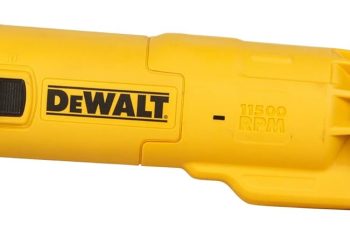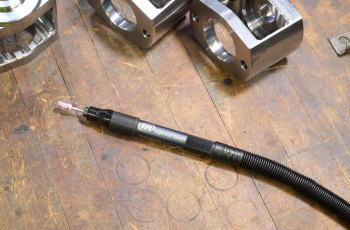Imagine you’re in a workshop, and you’ve got a die grinder in hand. Now, think about how the speed you choose can transform the surface finish of your workpiece. It’s not just about faster or slower; it’s about the perfect balance. Variable speed control offers a fascinating edge in precision, allowing you to tailor the process for each unique material. Curious about how this adaptability can elevate your craftsmanship?
Key Takeaways
- Variable speed control allows precise adjustments, enhancing surface finish quality by matching speed to material hardness.
- Customizable speeds prevent overheating, essential for softer materials like aluminum, ensuring superior surface quality.
- Seamless switching between abrasive products with variable speed improves workflow efficiency, maintaining consistent surface finish.
- Electronic controls stabilize RPM, providing consistent performance and reducing surface roughness in die grinding.
- Variable speed die grinders enable balancing of feed rate and cut depth, optimizing surface finish by minimizing roughness.
The Role of Spindle Speed in Grinding Performance
When it comes to grinding performance, spindle speed plays an essential role in determining the effectiveness and quality of the process. You see, spindle speed, measured in RPM or SFM, directly influences grinding efficiency by controlling how swiftly the grinding wheel spins. A higher spindle speed means more cutting edges engage the workpiece in less time, boosting the material removal rate. But, it’s important to match the spindle speed to the grinding wheel’s maximum operating speed to avoid damage. Modern machines with variable speed controllers offer the flexibility to adjust spindle speed without mechanical changes. This adaptability enhances grinding efficiency and allows for better surface finish by reducing heat build-up and minimizing thermal damage or burn marks on the workpiece. Optimizing spindle speed not only enhances grinding performance but also extends the longevity of the tools and the durability of the finished parts.
Balancing Speed With Other Grinding Parameters
Although spindle speed is essential for effective grinding, it’s just one piece of the puzzle when aiming for ideal surface finish and efficiency. You need to balance it with parameters like the depth of cut, feed rate, and grinding wheel grit size to optimize grinding efficiency and surface roughness. A smaller depth of cut generally results in finer finishes, but excessive depths can increase surface irregularities. Similarly, slower feed rates tend to produce smoother surfaces, while faster rates may compromise quality. Choosing the right grit size is vital; finer grits create smoother finishes, but coarser grits improve material removal. Don’t forget the role of machine condition and vibration, as these can greatly affect surface quality and grinding outcomes. Surface roughness is critical for applications in aerospace, automotive, and medical industries, as it impacts part performance and safety.
Advantages of Variable Speed Die Grinders
Due to their adaptability, variable speed die grinders offer substantial advantages across a variety of materials and applications. With speed adjustment capabilities, you can fine-tune RPMs to match material compatibility, reducing the risk of surface damage like smearing or melting. This feature is especially vital when working with non-woven or felt polishing discs, as it prevents overheating. You’ll find switching between different abrasive products seamless, boosting workflow efficiency without swapping machines. The ability to adjust speeds means you can tackle everything from rough material removal to delicate finishing, making these grinders perfect for tasks such as metal polishing, wood shaping, and stone carving. This versatility guarantees that you can match the speed to your specific task requirements, enhancing precision and control. Foredom offers unmatched precision with variable speed control, allowing for customizable performance based on the material and task at hand.
Technological Innovations in Variable Speed Control
Building on the versatility and precision offered by variable speed die grinders, recent technological innovations have further enhanced their functionality. With digital connectivity, you can now track your tool in real-time using your smartphone, thanks to technologies like ONE-KEY™. Electronic controls stabilize RPM, ensuring consistent performance regardless of material resistance. Brushless motors maintain torque and speed, even in tight spaces, extending the tool’s lifespan. The M18 FUEL™ Variable Speed Braking Die Grinder, for instance, features a POWERSTATE™ brushless motor which provides up to 20,000 RPM for maximum power and efficiency. Mechanical protection systems, such as Makita’s SJS™, prevent damage by allowing drive shafts to slip when needed. User ergonomics are improved with slide or paddle switches for better control. For those with fixed-speed grinders, aftermarket solutions provide adjustable speed functionality, offering a cost-effective way to achieve the precision you need without compromising on convenience.
Strategies for Optimal Surface Finish Using Variable Speed
When aiming for the perfect surface finish with variable speed die grinders, understanding how to adjust wheel speed is essential. Speed optimization lets you tailor the grinder’s performance to the material you’re working with, ensuring material compatibility. For instance, higher speeds suit hard materials like steel, improving surface finish by creating finer grinding marks. However, always stay within the wheel’s maximum operating speed for safety. Softer materials like aluminum require lower speeds to prevent overheating and surface damage. Use CNC programming or spindle speed controllers to effortlessly adjust speed without mechanical changes. Also, consider feed rate and cut depth; lower these to reduce surface roughness. By balancing these parameters, you’ll achieve a superior finish while maintaining efficient production times.
Conclusion
In summary, understanding and utilizing variable speed control in die grinding is essential for achieving optimal surface finishes. By adjusting spindle speeds based on material properties, you can enhance material removal rates for harder materials and prevent overheating in softer ones. This adaptability not only improves surface quality but also reduces defects, leading to more durable products. Embrace technological advancements and fine-tune your approach to guarantee precision, especially in demanding industries like aerospace and automotive.

